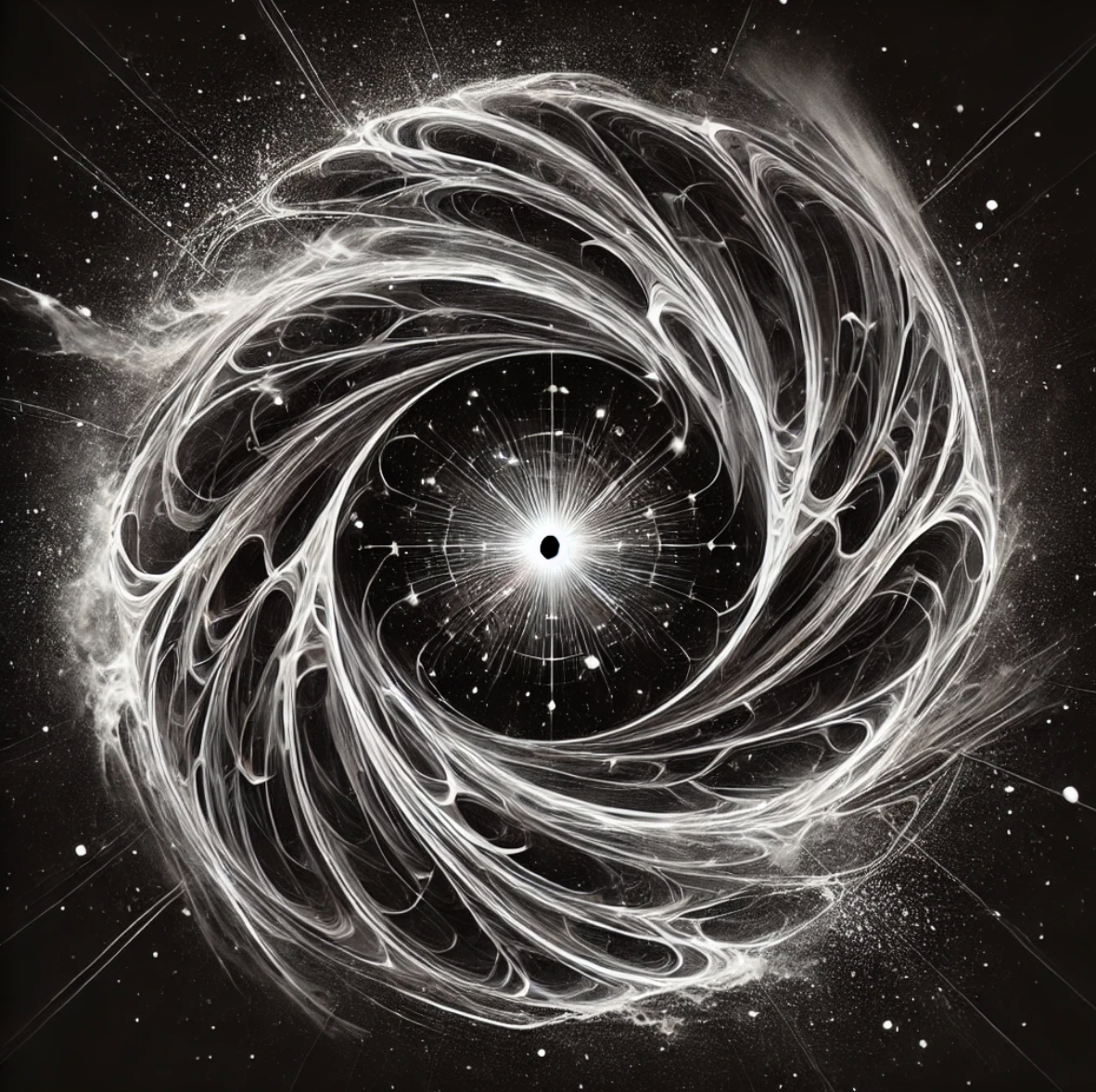With a suggestion of someone special, I admire & respect…
Inspired by ancient wisdom and driven by a quest to bridge spiritual truths with scientific understanding, I present a comprehensive exploration of the concept of entirety, a unifying principle that bridges ancient spiritual insights with modern scientific thought.
The Theory of Entirety is an attempt to unify the profound insights of ancient spiritual traditions with the rigorous frameworks of modern science. This journey was profoundly inspired by the work of Carl Sagan, whose relentless pursuit of understanding the origins of our existence opened new avenues of thought for me. Sagan’s ability to bridge the gap between scientific inquiry and the human quest for meaning motivated me to undertake a comparative study of holy scripts alongside scientific accomplishments. It is through this lens that I have sought to explore the totality of existence, or what I refer to as ‘entirety. Through this study, I aim to offer a framework that integrates the wisdom of the ages with the empirical rigor of modern science. The Theory of Entirety is not just a theoretical construct but a way of understanding the interconnectedness of all things, from the cosmic to the spiritual.
This theory posits that our ever-expanding universe is not an isolated phenomenon but exists in an infinite, unchanging framework—a cosmic entirety where phenomenon like birth of universe or multiverse takes place. Through the formulation of Σ=č²(0)1, this theory also offers the first scientific evidence of divinity, aligning ancient spiritual insights with modern science and revealing a profound interconnectedness that has eluded even the greatest scientific minds.
Holy Hymns of Hindu scriptures are not just holy; I consider them the holiest because they are evidently truthful, which I define as a divine order that transformed me from a devout Hindu into a seeking Hindu. Reading these hymns with their given meanings or translating them slowly became my habit—not because I was searching for God within them, but because I sought the truth in their claims of being ‘truly divine’ needing no further interpretation. The Durga Saptashati, a revered text from the Markandeya Purana, composed around the 5th-6th century AD, was one such scripture that captivated my attention which I began reading, not with religious intent, but driven by a deep curiosity to uncover the scientific truths they contained.
The depiction of Entirety was almost clear in these sacred verses[1] (“अहं ब्रह्मस्वरूपिणी…” and “यस्याः स्वरुपं ब्रह्मादयो न जानन्ति…”), but I could not grasp them quickly until I had a comparable study of modern scientists and their scientific accomplishments on it. These verses were articulating the essence of a reality that transcends all dualities—both the void and the fullness, the one and the many, the beginningless and endless. It was these hymns that ignited my journey into the depths of scientific exploration, motivating me to uncover the scientific truths embedded within these ancient insights.
As I delved deeper into this exploration, I first found these concepts logical, and eventually, tangibly true. It became apparent to me that no one had truly attempted to uncover the reasons behind preserving these ideas in the form of sacred texts, often attributed to scholars—whether religious or not—throughout history. Upon recognizing their truthfulness, I realized that even the most monumental scientific achievements had failed to fully grasp these profound concepts, partly because they were derived from religious scriptures, and partly due to the preservers’ own inactivity in rationalizing them with the changing times and advancing technology.
Now, it was indeed a great risk to claim that I had something new to introduce as a scientific concept derived from those overlooked and crucial truths hidden in ancient holy scripts. Yet, I knew I had to take this risk as a call of time.
As I continued my exploration, I recognized that even the most monumental scientific achievements had not fully captured these profound concepts. Albert Einstein, with his groundbreaking theory of relativity and the famous equation 𝐸=𝑚𝑐², laid the foundation for modern physics. However, his understanding was constrained by the limitations of the knowledge available in his time. The cosmological constant, which Einstein later dismissed as his “biggest blunder,” actually hinted at a deeper truth reflected in these holy hymns, but he was never close enough to grasp it: the universe is not a static entity, but a dynamic one existing within a greater, unchanging framework of the entirety. This framework, which I now refer to as the concept of Entirety, reveals the universe as an expanding entity within an infinite, immutable reality.
Stephen Hawking, another towering figure in cosmology, made significant contributions to our understanding of black holes and the nature of the universe. Yet, his strong reliance on empirical science led him to dismiss the possibility of a divine presence. By rejecting the concept of God, Hawking overlooked a crucial aspect of the cosmos—one that could have provided a more complete and unified understanding of the universe. So, there was no possibility with him to get these holy hymns reinterpreted scientifically, and my quest continued.
Inspired by these hymns and driven by the gaps I identified in the works of Einstein and Hawking, I found myself nearing the concept of Ultimate Zero (UZ), which emerged like a gift of adhering to the concept of Entirety on the ‘wall of time.’ This concept transcends traditional quantum fields and offers a perspective beyond conventional scientific paradigms. It finally led me to formulate Σ=č²(0)1, a concept that redefines time-space as a unique cosmic void—’1’—as the first scientific evidence of divinity, within which I found our universe as a tiny bubble within the vastness of Entirety. This finding was mindboggling because numerous concise concepts on divinity instantly aligned on its conformity desk for their self-verification.
The Vedic statement about the immovability of the divine, which these hymns reflect, had long stood unmatched. When I finally unraveled the reason behind this divine immovability, I discovered a scientific explanation for the oneness of creation—something that had never been done before. This creation, embodying all divine qualities, is indeed static, a belief that Einstein might have entertained but never fully embraced.
Now, it was my time to step forward. The concept of Entirety, as I present it, embodies the essence of a true static phenomenon. It is within this unchanging framework that our dynamic and expanding universe exists, forming the constant foundation that underlies all that is. This realization, inspired by ancient wisdom and refined through scientific inquiry, is the heart of the journey I have undertaken.
As a proud seeker and beneficiary of this timeless knowledge, I recognize that these ancient scriptures were not merely spiritual but were, in fact, scientific revelations preserved within a spiritual domain. The theory of Entirety offers not only a new perspective on the universe but also a bridge between these scientifically grounded truths and modern understanding. It is my hope that this work will inspire others to explore these connections further, to seek out the hidden truths in both the sacred and the scientific, and to continue the journey toward a more complete understanding of our existence.
In doing so, we may realize that a new chapter in the history of scientific discovery has been written—one that reawakens the ancient, yet ever-relevant, wisdom that has long awaited its validation.
[1] Markandey Puran: (मार्कण्डेय पुराण) (The same can be verified in Atharvshirsh of Durga Saptsati with full interpretation):
Aham Brahma Swaroopini. Matah Prakriti Purushaatmakam Jagat. Shoonyam cha Ashoonyam cha.
Aham Anandaananandau. Aham Vigyaanavigyaane. Aham Brahmabrahmani Veditavye. Aham Panchabhootanyapanchabhootani. Aham Akhilam Jagat. Vedohamavedoham. Yasyaah Swaroopam Brahmaadayo na jaananti tasmaat achyutey agyeya. Yasya antah na labhyate tasmaat achyutey ananta.
Yasya lakshyam na upalakshyate tasmaat achyutey alakshya. Yasya jananam na upalabhyate tasmaat achyutey aja. Ekaiva sarvatra vartate tasmaat achyutey eka.
Ekaiva vishwaroopini tasmaat achyutey naika. Ata evocyate agyeyaanantaalakshyaaja eka naika iti. Mantraanaam Maatrika Devi, Shabdanaam Gyaanaroopini. Gyaanaanaam Chinmayateeta Shoonyaanaam Shoonyasakshini.

